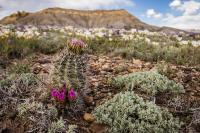
Threatened and Endangered Species
The BLM is a leader in the conservation of wildlife, fish, and plant species and their habitats. BLM-managed lands provide habitat for more than 3,000 special status species. The BLM Threatened and Endangered Species Program works to conserve all special status species, which include species federally listed as threatened or endangered and species identified as “sensitive” by the BLM. Special status species include mammals, reptiles, birds, amphibians, invertebrates, fish, and plants. Learn more on our special status species webpage.
Each BLM state organization has fish and wildlife biologists and botanists who work to conserve species and habitats. Biologists and botanists work together to protect habitat that species use throughout the year, such as for breeding, migration, or wintering. The BLM coordinates with state and federal agencies, Tribal governments, universities, industry, private landowners, non-governmental conservation organizations, and other partners to conserve and recover fish, wildlife, and plant species and their habitats on public lands. Learn more about our partners.
The priority of the BLM Threatened and Endangered Species Program is the proactive conservation and recovery of BLM special status species. By protecting and improving what we have today, we can increase conservation successes and avoid future species populations and habitat declines.
BLM Threatened and Endangered Species Program mission:
Conserve and recover BLM special status species by collaborating across programs and with our partners, implementing proactive, science-based ecosystem-level conservation, and communicating Threatened and Endangered Species Program successes within the BLM and to our partners and the public.
The BLM Strategic Plan for T&E Species, 2022-2027 describes the BLM’s priorities for conservation of wildlife, fish, plants and their habitat.






